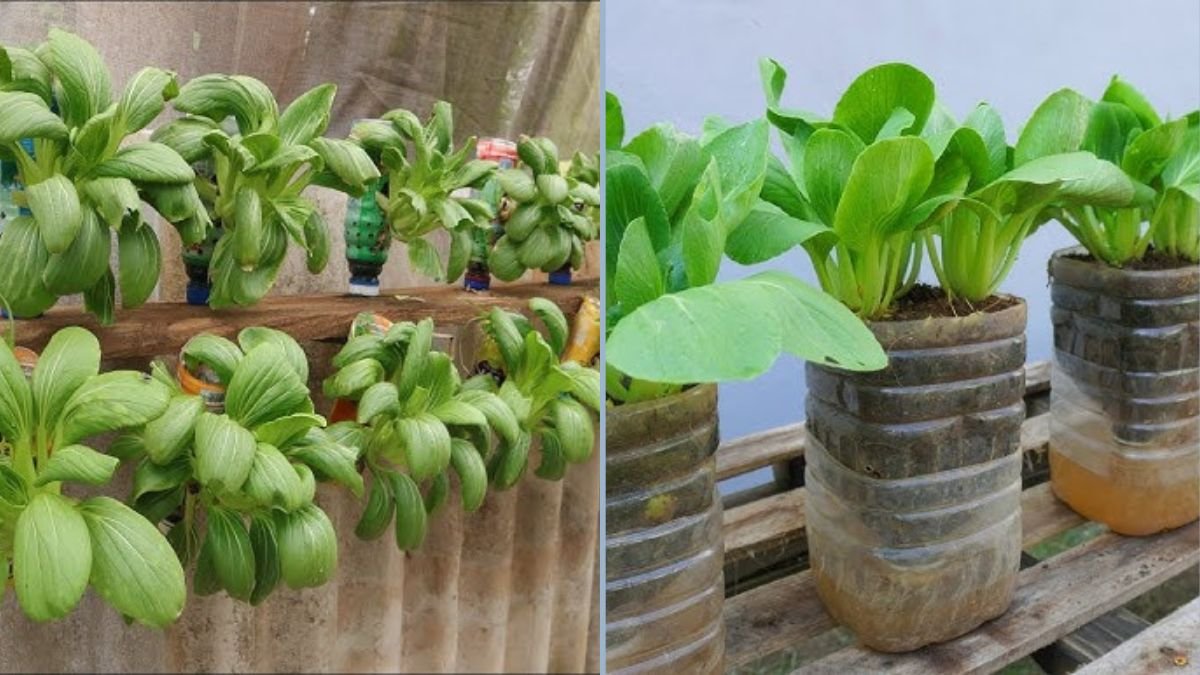Urban gardening has opened doors for creative ways to grow fresh vegetables at home, even when space is limited. One such innovative method is growing bok choy using recycled plastic bottles mounted on a wooden board. This technique not only promotes sustainability by reusing plastic waste but also provides an efficient, vertical growing system perfect for balconies, rooftops, or small patios.
Bok choy, also known as pak choi, is a leafy green vegetable widely used in Asian cuisine. Packed with vitamins, minerals, and antioxidants, it is a nutritious addition to salads, stir-fries, and soups. In this blog post, we’ll guide you step by step on how to grow bok choy creatively using plastic bottles on a wooden board, covering materials, planting, care, and harvesting tips.
Why Grow Bok Choy in Plastic Bottles on a Wooden Board?
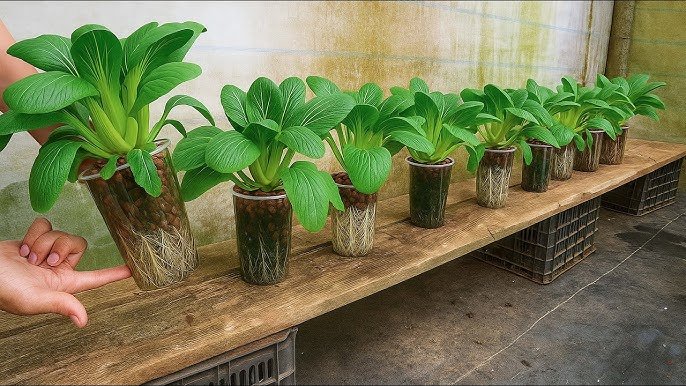
- Eco-Friendly: Repurposing plastic bottles reduces plastic waste while creating a productive gardening system.
- Space-Saving: Vertical planting on a wooden board maximizes small spaces, making it ideal for urban gardening.
- Cost-Effective: You can use everyday materials like bottles and scrap wood, minimizing expenses.
- Easy Maintenance: Watering and care are simplified with this vertical system, especially if a self-watering setup is used.
- Visual Appeal: A wooden board mounted with green, thriving bok choy plants adds a fresh, decorative touch to any space.
Materials You’ll Need
- Empty plastic bottles (1–2 liters recommended)
- Wooden board (size depends on your space)
- Screws or hooks for mounting bottles
- Drill or knife to cut holes
- Cotton string or cloth (optional for self-watering wick)
- Potting soil or compost-rich garden soil
- Bok choy seeds
- Water
- Small pebbles (optional for drainage)
Step-by-Step Guide to Growing Bok Choy on a Wooden Board
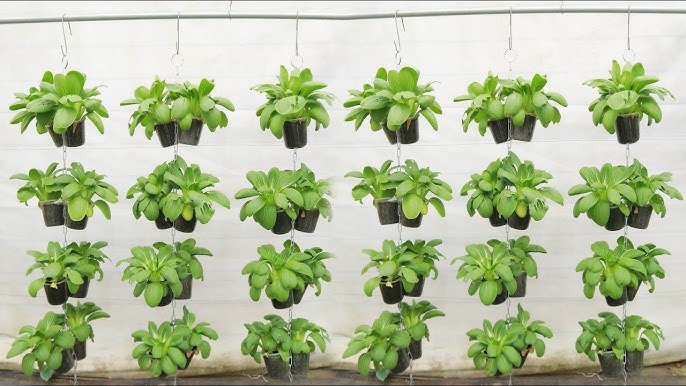
Step 1: Preparing the Plastic Bottles
- Wash the bottles thoroughly to remove any residue.
- Cut a rectangular opening on the side of the bottle to plant bok choy seeds or seedlings.
- Poke small holes at the bottom of the bottles for drainage. If using a wick system, thread cotton string from the bottom to the soil to ensure consistent moisture.
Step 2: Mounting the Bottles on the Wooden Board
- Decide on the spacing of the bottles on the wooden board. Leave at least 6–8 inches between each bottle for adequate sunlight and air circulation.
- Use screws, hooks, or brackets to secure each bottle horizontally or at a slight angle, depending on your preference.
- Ensure the bottles are stable and will not fall when filled with soil and water.
Step 3: Adding Soil and Preparing for Planting
- Optional: Add a small layer of pebbles at the bottom of the bottle for drainage.
- Fill each bottle with nutrient-rich soil or a mixture of garden soil and compost.
- Leave about an inch from the top for watering and planting.
Step 4: Planting Bok Choy Seeds or Seedlings
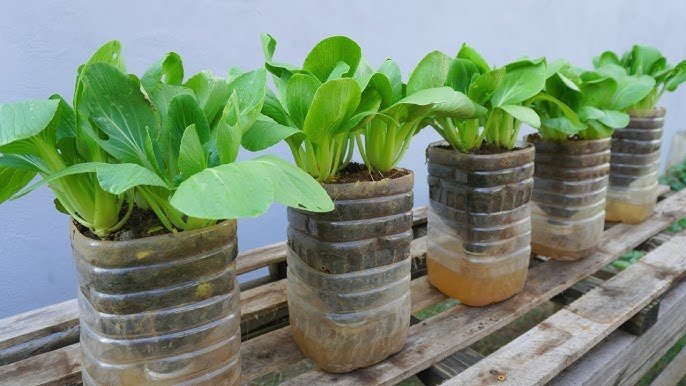
- Sow 2–3 seeds per bottle, spacing them evenly along the soil.
- Cover lightly with soil and press gently to ensure good contact.
- If planting seedlings, make a small hole in the soil and insert the seedling, pressing soil gently around the base.
- Water lightly to settle the soil and activate germination.
Step 5: Watering and Maintaining Moisture
- Water the soil immediately after planting and keep it consistently moist.
- If using a wick system, fill the bottom reservoir with water to allow gradual hydration of the soil.
- Check water levels regularly and refill as needed to prevent drying.
Caring for Bok Choy on a Wooden Board
- Sunlight: Place the board in a location receiving 4–6 hours of sunlight daily. Bok choy grows best with ample light but can tolerate partial shade.
- Fertilizing: Use a diluted liquid fertilizer every 2–3 weeks to support strong leafy growth.
- Thinning Seedlings: Once seedlings grow 2–3 inches tall, thin weaker plants to avoid overcrowding.
- Pest Management: Bok choy can attract aphids or caterpillars. Treat naturally using neem oil or mild soap spray.
- Pruning: Remove yellowing leaves to promote airflow and plant health.
Harvesting Bok Choy
- Bok choy grows quickly, and you can start harvesting leaves 3–4 weeks after planting.
- Pick outer leaves first, allowing the inner leaves to continue growing for continuous harvest.
- For full heads, wait until plants reach 6–8 inches in height before harvesting.
- Harvest regularly to encourage new growth and maximize yield.
Benefits of Growing Bok Choy in This System
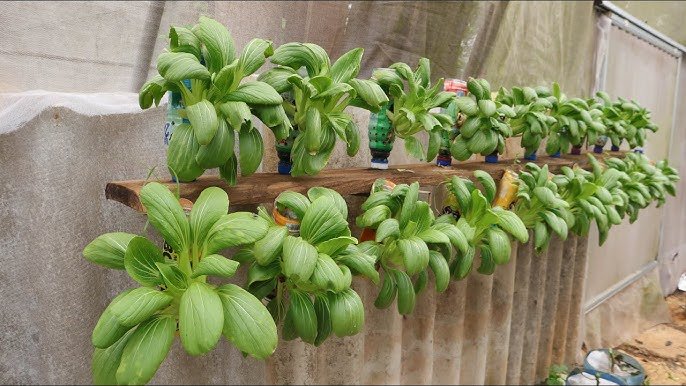
- Continuous Supply: Vertical planting allows you to grow multiple bottles, ensuring a steady supply of fresh greens.
- Nutrient-Rich Produce: Homegrown bok choy is more nutritious and flavorful than store-bought varieties.
- Efficient Space Use: Ideal for apartments, rooftops, or small balconies.
- Eco-Friendly Gardening: Reusing plastic bottles reduces waste while promoting sustainability.
- Aesthetic and Functional: Adds greenery to your living space and serves as a conversation piece.
Common Mistakes to Avoid
- Overcrowding Plants: Too many seeds or seedlings per bottle can stunt growth. Thin as needed.
- Neglecting Water: Even vertical systems require monitoring. Refill reservoirs and check soil moisture.
- Insufficient Sunlight: Bok choy requires moderate sunlight; lack of light can lead to leggy, weak leaves.
- Overfertilizing: Excess fertilizer can damage plants and affect taste.
- Ignoring Pests: Inspect regularly for aphids or caterpillars and act promptly.
Tips for Year-Round Growth
- Indoor Setup: Place the board near a sunny window or use grow lights during colder months.
- Succession Planting: Sow new seeds every 2–3 weeks to maintain a continuous supply.
- Rotate the Board: If sunlight comes from one direction, rotate the board occasionally to ensure even growth.
- Use Different Varieties: Experiment with baby bok choy or larger varieties for diverse harvests.
Expanding Your Vertical Bottle Garden
Once you’ve successfully grown bok choy, you can extend this creative system to other leafy greens and herbs:
- Lettuce
- Spinach
- Kale
- Cilantro
- Basil
By using a wooden board and recycled bottles, you can build a multi-level vertical garden, making the most of your limited space while producing fresh, homegrown food year-round.
Conclusion
Growing bok choy using plastic bottles mounted on a wooden board is an innovative, eco-friendly, and space-saving solution for urban gardeners. This method not only recycles waste but also allows you to enjoy fresh, nutrient-rich greens at home with minimal effort.
By following these steps—from preparing bottles and mounting them on a board to planting, watering, and harvesting—you can create a productive vertical garden that is both functional and visually appealing. Whether you are an apartment dweller, balcony gardener, or sustainability enthusiast, this creative idea offers a practical and rewarding approach to growing bok choy and other vegetables year-round.
Start your vertical bottle garden today and transform ordinary plastic waste into a thriving, healthy, and green edible space.
